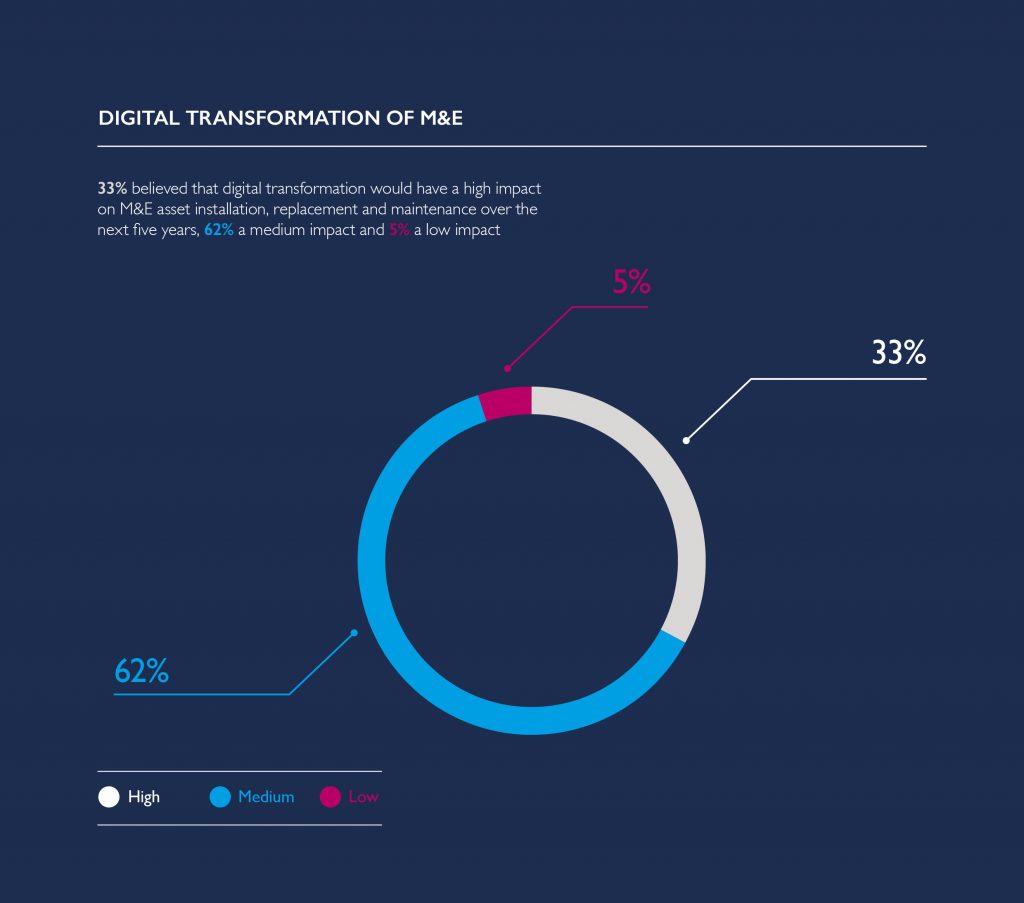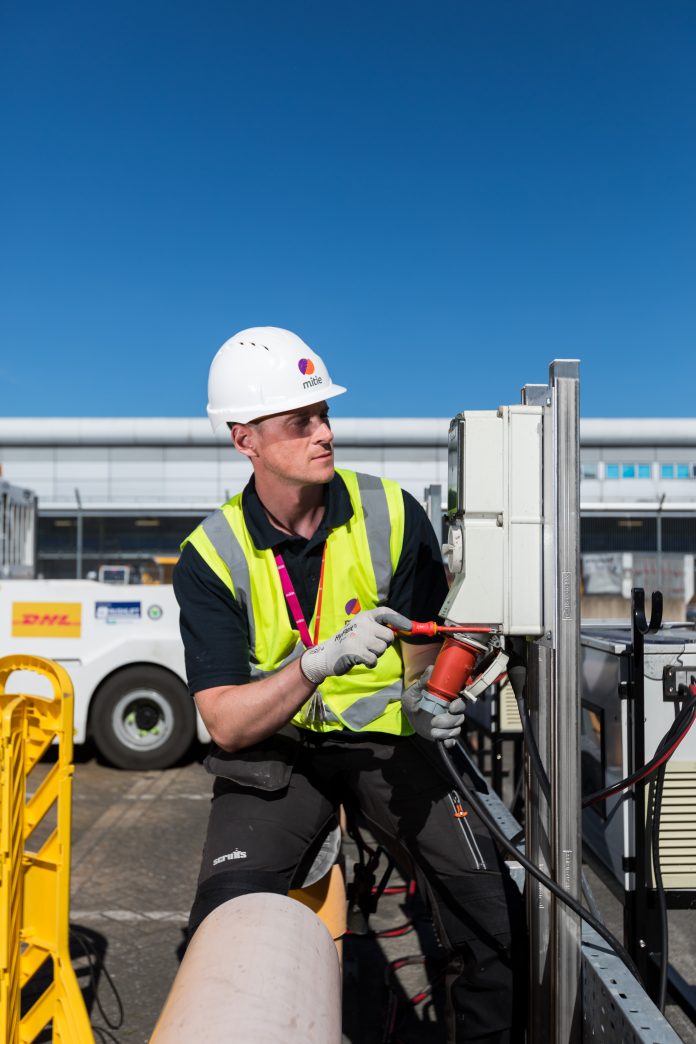A new report from Mitie looks at the rise of digital transformation in M&E services. Here, Carlo Alloni, managing director of technical services, discusses the findings and the business benefits of embracing digital
Digital transformation is happening all around us. In our personal lives we’re constantly connected, and it’s increasingly complementing our working lives too, although some sectors are clearly more advanced than others.
As an industry, there is real opportunity to be gained from digital transformation – both in terms of evolving our M&E services, identifying new opportunities and, ultimately, delivering better value for clients. In particular, we’re finding that data analytics, digital twins, automation and building management systems are creating new opportunities for predictive maintenance. So we decided to dig a little deeper and find out what facilities managers really think in our recent report, Digital Transformation: Is Facilities Management Ready?.
Downtime is money
Everyone wants their buildings and infrastructure assets to run at optimal levels, without disruption. It’s a no brainer really – businesses need to be able to function. However, for many companies, minimising downtime is essential to an organisation’s productivity and its bottom line. For example, if you’re running a manufacturing plant, every minute lost impacts production.
As the saying goes, prevention is better than the cure, so if we can pre-empt that cause, we can offer an invaluable service to clients. Such initiatives to reduce risk are in high demand, so it’s unsurprising that an overwhelming 95% of respondents to our recent survey believe digital transformation will either have a high or at least medium impact on mechanical and electrical (M&E services) asset installation, replacement and maintenance over the next five years.
Digital transformation offers the opportunity to gather the data we need to implement resilient infrastructure assets. That data can be drawn from a range of sources, including a business’ buildings, processes and people, or from specially installed Internet of Things (IoT) sensors. In fact, a high proportion of new mechanical and electrical equipment on the market today is pre-wired to be IoT-ready.
However, the real value of digital transformation is not in the data collection. It’s in analysing the data to drive real, actionable insights. It sounds simple, but the conversion to action is a step many people neglect.
We already do this for many of our customers today from our Service Operation Centre in Bracknell. We create what is essentially a ‘digital twin’, an exact cloud-based replica of a customers’ sites allowing us to remotely monitor and analyse the performance of their facilities. This ‘digital twin’ can monitor anything from infrastructure assets to energy management, and wellbeing and comfort policies.
Predict to prevent
When it comes to maintaining assets, knowing a certain piece of kit is likely to fail means you can prevent issues before they arise. This is transformative for M&E services. Engineering maintenance today is largely reactive and driven by human interaction, but digital transformation can change all that.
In fact, we think the revolution is already here, as more than a quarter of our survey respondents (27%) claimed to have already made significant progress on digitising their “asset installation, replacement and maintenance”. Suppliers who aren’t part of the movement will surely be left behind.
Reactive repair will eventually be obsolete as when an asset fails, its fix is reliant on someone noticing and logging a fault. An engineer is then called, who travels out to check on the issue, diagnoses the problem and orders apart, which can take days to be delivered, and then the engineer still has to travel back to the site again to make the repair. This involves at least two engineer journeys and many hours of asset downtime, which could seriously impact production, performance, and comfort within the business.
In comparison, a predictive repair approach instead detects an anomaly by monitoring essential operating parameters and checking for anything falling outside of tolerance, such as vibration within an air conditioning unit.
Analytics identify the source of the anomaly and predict component failure. A replacement part is ordered and an engineer scheduled to arrive onsite to coincide with the delivery of the part. So far, all this has happened automatically. The engineer arrives onsite, replaces the part, tests it and the asset returns to normal operation with minimal disruption.
Journeys to the site and delays have been reduced and the work has been completed with zero downtime and minimal impact to the customer’s site. It essentially means that you can resolve customer maintenance issues before they even happen. It’s what we want to happen at our own sites, so this is exactly the level of service I think we should be providing to our customers.
Bump up your BMS
It all sounds great, right? But none of this is possible without the assistance of a decent building management system (BMS) – and by decent, I don’t mean it has to be flashy. An existing BMS can provide a bridge between new digital innovations and existing legacy infrastructure.
A third (34%) of the people in our survey are clearly keen to leverage their BMS system, as they said “automated building controls” are an essential element of delivering a digitally connected workplace. A site’s assets may typically be older but, by using a BMS to connect into these legacy assets, you can monitor them without the investment of a huge capital project or needing to buy new assets with built-in sensors.
We’re seeing that the benefit of connecting to older assets via a BMS is particularly relevant, given that 39% of our survey respondents cited “legacy system replacement costs” as one of the top barriers to realising business value.
However, a BMS isn’t necessarily a panacea, as they can become outdated themselves, creating barriers of their own. If a system is “closed protocol”, it’s harder for anybody to go in and maintain it, connect to it, pull the data out, and start to run analytics algorithms. So, in order to create true connection, organisations need to ensure they have a modern open protocol BMS, which enables connectivity and software optimisation.
The Connected Engineer
The potential impact of digital transformation on M&E services doesn’t end there.
The advent of industrial 5G and the resulting boost to augmented reality capabilities opens up new opportunities. We’re already exploring a new service called the Connected Engineer through which field engineers equipped with mixed reality smart glasses can, quickly and conveniently, draw upon a wealth of up-to-the-minute data and additional expertise.
Combining augmented reality with wearables allows our engineers to do the work they need to, hands-free, yet still have up-to-date asset data without having to carry documents, drawings or manuals. They can also share what they’re seeing with our remote monitoring Service Operations Centre team to draw upon additional experience, support and specific asset expertise should they need to. Essentially, it ensures an optimum, efficient right-first-time fix, which is a win for our client and a win for us.
It’s clear that there are digital transformation opportunities for M&E maintenance, repair and installation, and it’s something our clients are looking for us to deliver. It’s also core to us in adding value for our clients, whether that be reduced downtime or limiting the irritation of lengthy fixes on faulty assets.
And digital transformation goes even further than this. It enables us to capture information, and therefore provide insights that offer benefits way beyond just maintenance to almost every aspect of the business – such as energy savings, CO2 reduction and ensuring the most efficient use of assets and space. One thing is certain: suppliers who don’t use digital transformation to create tangible building and business resilience will be left behind.

Carlo Alloni
Managing director, technical services
Twitter: @mitie
LinkedIn: mitie














